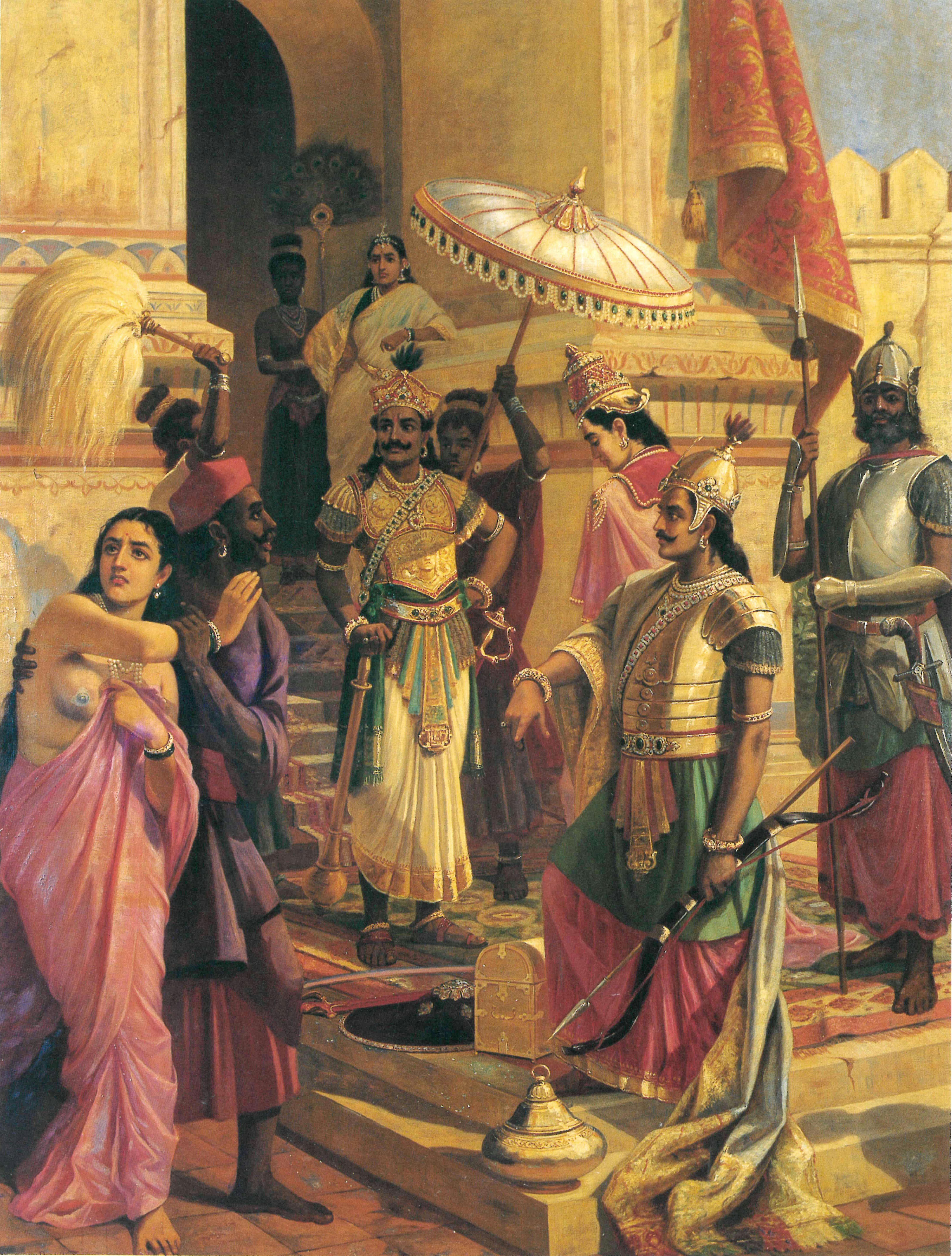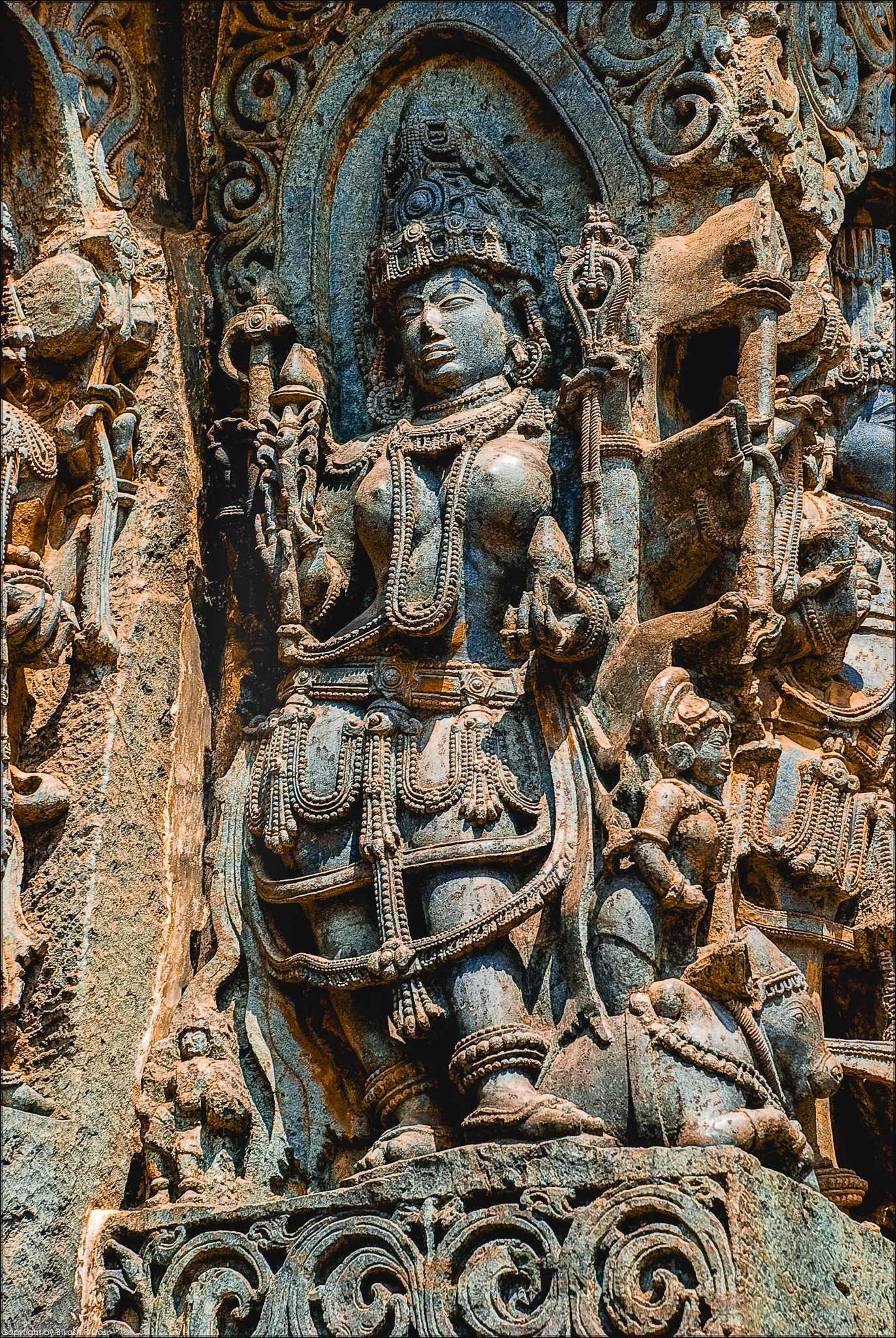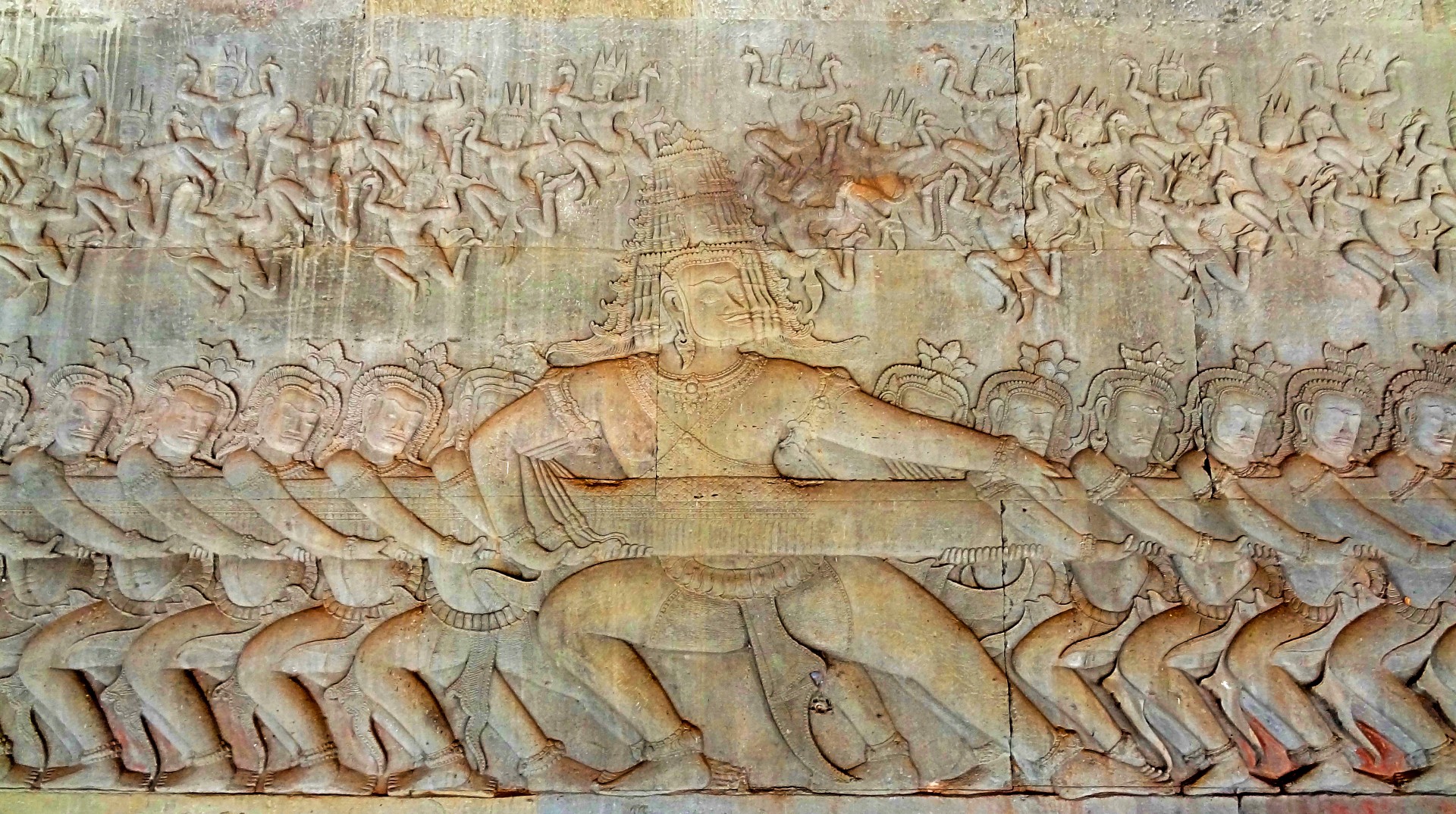|
Indrani
Indrani (Sanskrit: इन्द्राणी, IAST: ''Indrāṇī''), also known as Shachi (Sanskrit: शची, IAST: ''Śacī''), is the queen of the Deva (Hinduism), devas in Hinduism. Described as tantalisingly beautiful, proud and kind, she is the daughter of the asura Puloman and the consort of the king of the Deva (Hinduism), devas, Indra. According to legend, due to her heavenly beauty and sensuality, Indrani was desired by many men, many of whom tried to marry her. When Indra was away performing his penance for the slaying of Vritra, Vritasura, Nahusha, a mortal king of the Lunar dynasty, was chosen as the ruler of heaven. The latter tried to seduce Shachi and make her his queen, though she cleverly executed a scheme to dethrone him and later reunite with her husband. Indrani (or Aindri) is also one of the Sapta Matrika—the seven divine mothers. She is an important goddess in Shaktism, a major sect of Hinduism. Indrani is rarely worshipped as an independent deity ... [...More Info...] [...Related Items...] OR: [Wikipedia] [Google] [Baidu] [Amazon] |
Indrani (name)
Indrani is a feminine Indian name. Indrani is the name of Shachi, wife of Hindu God Indra. List of persons with the given name *Indrani Haldar (born 1971), Indian actress *Indrani Sen, Bengali singer *Indrani Mukherjee, Indian actress *Indrani (photographer) Indrani Pal-Chaudhuri, director, photographer, social justice advocate, Canadian-British-Indian. *Indrani Pal-Chaudhuri, director, photographer, social justice advocate, Canadian-British-Indian. *Indrani Rahman (1930–1999), Indian dancer *Indrani Dutta (born 1970), Indian actress *Indrani Mukerjea (born 1972), INX Media CEO *Indrani Paul (born 2000), Indian actress and model *Indrani of Sambhupura List of people with the surname * Seeta Indrani (born 1963) British actress and dancer {{surname Indian feminine given names Feminine given names ... [...More Info...] [...Related Items...] OR: [Wikipedia] [Google] [Baidu] [Amazon] |
Matrika
Matrikas (Sanskrit: मातृका (singular), IAST: mātṛkā, lit. "mothers") also called Mataras or Matri, are a group of mother goddesses in Hinduism. The Matrikas are often depicted in a group of seven, the Saptamatrika(s) (Seven Mothers). However, they are also depicted as a group of eight, the Ashtamatrika(s). In the '' Brihat Samhita'', Varahamihira says that "Matrikas are forms of Parvati taken by her with cognizance of (different major Hindu) gods corresponding to their names." They are associated with these gods as their energies (''Shaktis''). Brahmani emerged from Brahma, Vaishnavi from Vishnu, Maheshvari from Shiva, Indrani from Indra, Kaumari from Kartikeya, Varahi from Varaha and Chamunda from Chandi. And additionals are Narasimhi from Narasimha and Vinayaki from Ganesha. Originally the seven goddesses of the seven stars of the star cluster of the Pleiades, they became quite popular by the seventh century CE and a standard feature of the Hindu goddes ... [...More Info...] [...Related Items...] OR: [Wikipedia] [Google] [Baidu] [Amazon] |
Indra
Indra (; ) is the Hindu god of weather, considered the king of the Deva (Hinduism), Devas and Svarga in Hinduism. He is associated with the sky, lightning, weather, thunder, storms, rains, river flows, and war. [3 volumes] Indra is the most frequently mentioned deity in the ''Rigveda''. He is celebrated for his powers based on his status as a god of order, and as the one who killed the great evil, an Asura (Hinduism), asura named Vritra, who obstructed human prosperity and happiness. Indra destroys Vritra and his "deceiving forces", and thereby brings rain and sunshine as the saviour of mankind. Indra's significance diminishes in the post-Vedic Indian literature, but he still plays an important role in various mythological events. He is depicted as a powerful hero. According to the ''Vishnu Purana'', Indra is the title borne by the king of the gods, which changes every Manvantara – a cyclic period of time in Hindu cosmology. Each Manvantara has its own Indra and the In ... [...More Info...] [...Related Items...] OR: [Wikipedia] [Google] [Baidu] [Amazon] |
Shakti
Shakti (Devanagari: शक्ति, IAST: Śakti; 'energy, ability, strength, effort, power, might, capability') in Hinduism, is the "Universal Power" that underlies and sustains all existence. Conceived as feminine in essence, Shakti refers to the personified energy or power of a Deva (Hinduism), male deity, often personified as the female consort of the given Hindu god. In Tantric Shaktism, Shakti is the foremost deity, akin to Brahman. In Puranic Hinduism, Shiva and Shakti are the masculine and feminine principles that are complementary to each other. The male deity is ''purusha'', pure consciousness, which creates the universe through the female creative energy of Shakti, which is ''Prakṛti, prakriti'', 'nature'. The term ''Shakta'' is used for the description of people associated with Shakti worship. The Shakta pithas are shrines, which are believed to be the sacred seats of Shakti. Etymology and overview According to the Monier Monier-Williams, Monier-Williams dict ... [...More Info...] [...Related Items...] OR: [Wikipedia] [Google] [Baidu] [Amazon] |
Shaktism
Shaktism () is a major Hindu denomination in which the God in Hinduism, deity or metaphysics, metaphysical reality is considered metaphorically to be a woman. Shaktism involves a galaxy of goddesses, all regarded as different aspects, manifestations, or personifications of the divine feminine energy called ''Shakti''. It includes various modes of worship, ranging from those focused on the most worshipped Durga, to gracious Parvati, and the fierce Kali. After the decline of Buddhism in India, various Hindu and Buddhist goddesses were combined to form the Mahavidya, a Pantheon (religion), pantheon of ten goddesses. The most common forms of the Mahadevi worshipped in Shaktism include: Durga, Kali, Saraswati, Lakshmi, Parvati, and Tripura Sundari. Also worshipped are the various Gramadevatas across the Indian villages. Shaktism also encompasses various Tantra#Śaiva and Śākta tantra, tantric sub-traditions, including Vidyapitha and Kulamārga. Shaktism emphasizes that intense ... [...More Info...] [...Related Items...] OR: [Wikipedia] [Google] [Baidu] [Amazon] |
Svarga
Svarga (, ), also known as Swarga, Indraloka and Svargaloka, is the celestial abode of the devas in Hinduism. Svarga is one of the seven higher lokas ( esoteric planes) in Hindu cosmology. Svarga is often translated as heaven, though it is regarded to be dissimilar to the concept of the Abrahamic Heaven. Description Svarga is a set of celestial worlds located on and above Mount Meru, where those who had led righteous lives by adhering to the scriptures delight in pleasures, before their next birth on earth. It is described to have been built by the deity Tvashtar, the Vedic architect of the devas. The king of the devas, Indra, is the ruler of Svarga, ruling it with his consort, Indrani. His palace in the abode is called Vaijayanta. This palace holds the famous hall, Sudharma, unrivalled among all the princely courts. The capital of Svarga is Amaravati, and its entrance is guarded by the legendary elephant, Airavata. Svarga is described to be the home of Kamadhenu, the c ... [...More Info...] [...Related Items...] OR: [Wikipedia] [Google] [Baidu] [Amazon] |
Devi
''Devī'' (; ) is the Sanskrit word for 'goddess'; the masculine form is Deva (Hinduism), ''deva''. ''Devi'' and ''deva'' mean 'heavenly, divine, anything of excellence', and are also gender-specific terms for a deity in Hinduism. The concept and reverence for goddesses appears in the Vedas, which were composed around the 2nd millennium BCE. However, they did not play a vital role in that era. Goddesses such as Durga, Kali, Lakshmi, Parvati, Radha, Saraswati and Sita have continued to be revered in the modern era. The medieval era Puranas witness a major expansion in mythology and literature associated with Devi, with texts such as the ''Devi Mahatmya'', wherein she manifests as the ultimate truth and supreme power. She has inspired the Shaktism tradition of Hinduism. Further, Devi is viewed as central in the Hindu traditions of Shaktism and Shaivism. Etymology ''Devi'' and ''deva'' are Sanskrit terms found in Vedic literature around the 3rd millennium BCE. ''Deva'' is masculi ... [...More Info...] [...Related Items...] OR: [Wikipedia] [Google] [Baidu] [Amazon] |
Nahusha
Nahusha (, ) is a king of the Chandravamsha (Lunar dynasty) in Hindu Puranas and Mahabharata. He is described to be the son of Āyus, the eldest son of Pururavas, and Prabha, the daughter of Svarbhānu. Literature Nahusha is mentioned often in the Rigveda, starting in Mandala 1. Nahusha reigned from Pratishthana. According to the '' Harivamsha'', the appendix of the epic ''Mahabharata'', he married Viraja, the mind-born daughter of the Pitrs. They had six or seven sons, according to different scriptures. His eldest son Yati became a '' muni'' (ascetic). He was succeeded by his second son, Yayati. According to the ''Padma Purana'', Nahusha married Ashokasundari, she is said to have given birth to Yayati and a hundred daughters of Nahusha. Legend Birth and early life According to the Padma Purana, Ashoksundari would marry the son of Ayu. Once, when the asura Hunda entered the grove, he desired Ashoksundari, but the latter informed him of her mother's prophecy. Hunda ass ... [...More Info...] [...Related Items...] OR: [Wikipedia] [Google] [Baidu] [Amazon] |
Jayanta
Jayanta ()), is a character who appears in Hindu literature. He is the son of Indra, the king of the devas (gods), and his wife, Shachi (Indrani). He has a sister called Jayanti. He appears in various Hindu scriptures, fighting in wars on behalf of the devas. Jayanta also appears in the epic ''Ramayana'' and other lore, in which he disguises himself as a crow. Legends Crow form In the '' Sundara Kanda'' (the fifth Book of the epic ''Ramayana''), when Hanuman meets Sita, she narrates an incident that happened in the forest in Chitrakuta. The prince of Ayodhya and an avatar of the god Vishnu, Rama, is exiled to the forest with his wife Sita (an avatar of Vishnu's wife, Lakshmi) and his brother, Lakshmana. A fatigued Rama was sleeping in the lap of Sita, when a crow attacked her. The crow pecks at her twice; once on her breast or between her breasts in some versions. The ''Ramcharitmanas'' replaces the breast with feet. In a hurry to drive away the crow, she tries to fas ... [...More Info...] [...Related Items...] OR: [Wikipedia] [Google] [Baidu] [Amazon] |
Asura
Asuras () are a class of beings in Indian religions, and later Persian and Turkic mythology. They are described as power-seeking beings related to the more benevolent Devas (also known as Suras) in Hinduism. In its Buddhist context, the word is translated as "titan" or " antigod". According to Hindu texts, the asuras are in constant fear of the devas. Asuras are described in Indian texts as powerful superhuman demigods with good or bad qualities. In early Vedic literature, the good Asuras are called '' Adityas'' and are led by Varuna, while the malevolent ones are called '' Danavas'' and are led by Vritra. In the earliest layer of Vedic texts, Agni, Indra and other gods are also called Asuras, in the sense of their being "lords" of their respective domains, knowledge and abilities. In later Vedic and post-Vedic texts, the benevolent gods are called ''Devas'', while malevolent Asuras compete against these Devas and are considered "enem ... [...More Info...] [...Related Items...] OR: [Wikipedia] [Google] [Baidu] [Amazon] |
Vritra
Vritra (, , ) is a danava in Hinduism. He serves as the personification of drought, and is an adversary of the king of the devas, Indra. As a danava, he belongs to the race of the asuras. Vritra is also known in the Vedas as Ahi ( ). He appears as a human-like serpent blocking the course of the Rigvedic rivers, and is slain by Indra with his newly forged vajra. Etymology ''Vritra'' literally means "cover, obstacle", in reference of him holding back the waters. It stems from Proto-Indo-Iranian ''*wr̥trás'', from the Proto-Indo-European root ''*wer-'' "to cover, to obstruct". The Indo-Iranian word is also found in Avestan as '' vərəθraγna'' (Vedic ''vṛtraghná''), literally "(one who) slays obstacles". Functionally, he is related to Jörmungandr of Norse myth, Typhon of Greek myth, and Veles of Slavic myth. Literature Vedas According to the Rig Veda, Vritra kept the waters of the world captive until he was killed by Indra, who destroyed all the 99 fortresses ... [...More Info...] [...Related Items...] OR: [Wikipedia] [Google] [Baidu] [Amazon] |
Shachihoko
A – or simply – is a sea monster in Japanese folklore with the head of a dragon or tiger or lion and the body of a carp covered entirely in black or grey scales.Joya. ''Japan and Things Japanese.'' Taylor and Francis, 2017;2016;, According to the tale, Shachihoko lives in the cold northern ocean. Its broad fins and tail always point up toward heaven, and its dorsal fins have numerous sharp spikes. It can swallow a massive amount of water and hold it in its belly, as well as summon clouds and control the rain.Meyer, Matthew. “Shachihoko.” ''YOKAI.COM'', https://yokai.com/shachihoko/ . Accessed 3 December 2022. Although believed to come from the sea, they are often constructed high on the roof standing upside down. 鯱 is a kokuji character; when pronounced , it can mean " orca". Origins Shachihoko evolved from '' Chiwen'', an animal in the Chinese tale from the Han dynasty (202 BC - 220 AD), and is known as Shibi in Japan. First found in the Eastern Han dynasty po ... [...More Info...] [...Related Items...] OR: [Wikipedia] [Google] [Baidu] [Amazon] |







